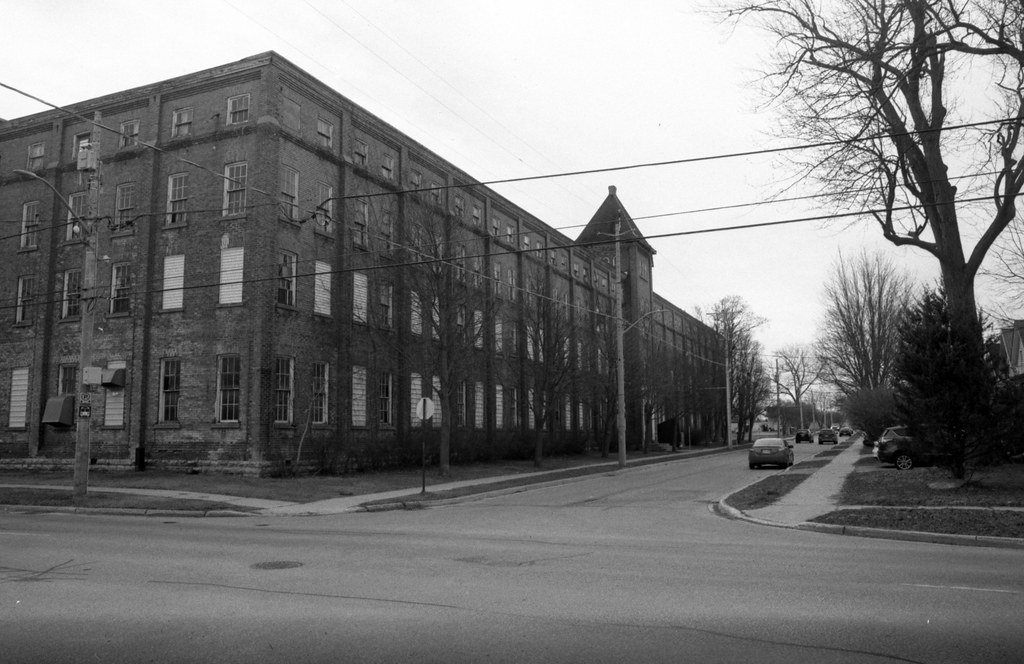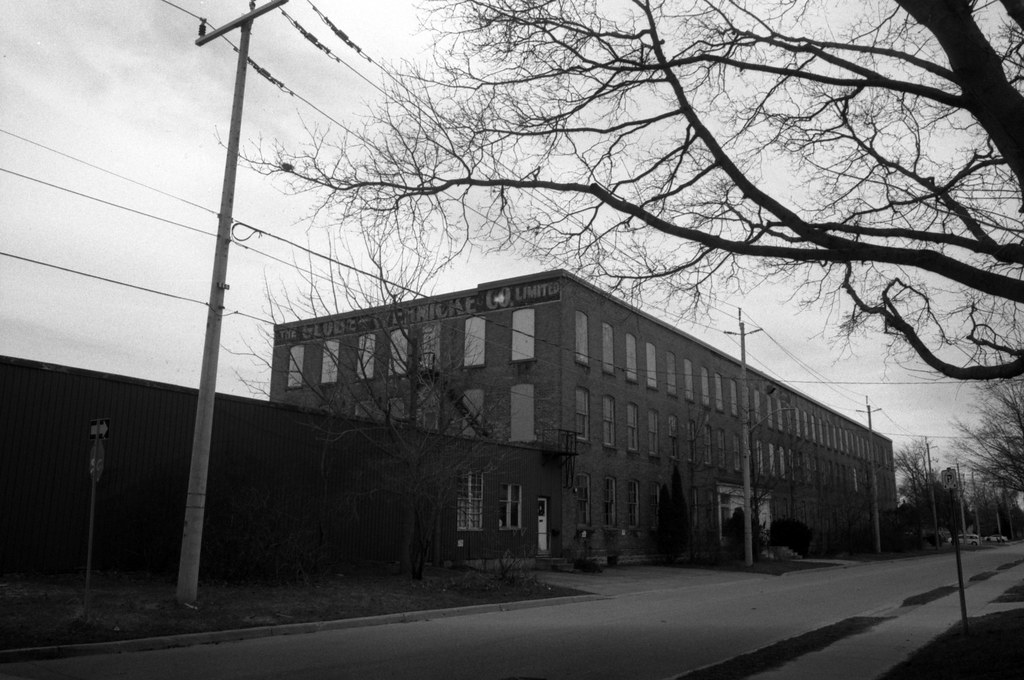We start this week with high school English. I don’t know about you, but English seemed to love the topic of Shakespeare. Don’t get me wrong. Shakespeare is brilliant but way over analysed by the average high school student, but what does that have to do with photography? One of my first favourite historical downtowns in Ontario. That reason is Stratford, Ontario. I remember one of my first visits to the city in 2009, and it quickly became a spot where I would test out a new camera and clearly shows what a late 19th-Century City in Ontario once looked like.

Nikon FM – AI Nikkor 28mm 1:3.5 (Yellow-12) – Fomapan 200 @ ASA-200 – Adox Atomal 49 (Stock) 10:00 @ 20C
While the Canada Company is not directly responsible for Stratford, Ontario’s founding, they are partly connected. During the Huron Road creation, a colonisation road that ran from Guelph, Ontario to Goderich, and today is continued by several different King’s Highway; several smaller settlements grew up along the route as rest and resupply points for colonists and workers. The first settlement of what is now Stratford began in 1828, although any major construction would not start until 1832. Thomas Mercer, deputy governor of the Canada Company, directed the construction of a sawmill, grist mill, and the Shakespeare Hotel, naming the Thames River section to River Avon through the small settlement. The connection with the bard stuck, and when a post office arrived in 1835, Stratford’s name was given to the small settlement. Surprisingly, the small settlement grew quickly, despite being a stop along the way, with agriculture, lumber being the two early industries and various hospitality services for those travelling the Huron Road. When Perth County was created, Stratford being the regions largest population centre, was named county seat and incorporated as a village in 1854. In 1856 two major railroads arrived in the village, Grand Trunk and Buffalo & Lake Huron (Buffalo & Lake Huron would fall under Grand Trunk’s Control within a decade). Even a young telegraph operator named Thomas Edison, who worked for Grand Trunk, lived in Stratford briefly. Stratford was incorporated as a town in 1859. The presence of a major railroad hub attracted several secondary industries to the town. The biggest was furniture production. The Abraham & Hepburn Factory opened with ten people in 1867. Stratford quickly became a major railroad hub for Grand Trunk’s ever-increasing network, and in 1871 they opened a massive switching and repair yard. In the 1880s, Stratford’s fortunes were riding high; by 1885 and a population of 9,000, Stratford saw incorporation as a city. A new county court built in the High Victorian style was completed in 1887, and a Picturesque Victoria City Hall was completed in 1898. By the 20th Century, Stratford was booming. A teacher’s college, public library, armoury, and even larger furniture production factories had opened in the city. Grand Trunk completed a massive locomotive repair shop on Cooper Street in 1909, one of the last major railway firms’ projects. The first pair of Stratford’s now-iconic swans first arrived in 1918. Stratford’s fortunes were still riding high, and the furniture industry peaked in 1920, with a sixth of all furniture in Canada being produced in the city. But the great depression took its toll, and in 1933 most of the city’s workforce had walked off the job in a general strike to protest poor working conditions, poor wages, and near-constant layoffs. When the local police failed to protect replacement (non-union) workers, the Canadian Militia arrived in force, and while there was some violence, no striking workers were killed. It marked the final time the military was used to break a strike. By the 1950s, many things were starting to slide, furniture factories were closing, and the Cooper Shops became obsolete with the rise in diesel locomotives. Local journalist Tom Patterson, not wanting to see the city fall deep into decline, banked on the city’s connection to Shakespeare, and in 1952 launched the Stratford Festival that featured live performances of the Barb’s plays opening season launching in 1953. The idea was to fill a gap in the local economy with tourism. And it worked partly, with a permanent theatre opening in 1957. Still, the closure in 1964 of the Cooper Shops left a huge gap in the city’s industry; even the furniture industry began to decline. The teacher’s college also closed in 1973. Although the Stratford Festival continued to bring in tourists and ongoing beautification projects, it put Stratford back on the map, named the prettiest city in the world in 1997. And while the last furniture plant closed in 2006, the Stratford Festival continues to keep the city alive and vibrant and now occupies several buildings and has expanded beyond Shakespeare’s plays.

Nikon FM – AI Nikkor 28mm 1:3.5 (Yellow-12) – Fomapan 200 @ ASA-200 – Adox Atomal 49 (Stock) 10:00 @ 20C
Nikon FM – AI Nikkor 28mm 1:3.5 (Yellow-12) – Fomapan 200 @ ASA-200 – Adox Atomal 49 (Stock) 10:00 @ 20C
Our walking route during our visit did not take us through the downtown for much of the time, at least the main street (Ontario Street or Highway 7/8), which is where many of my favourite subjects are located, which proved useful in choosing which images to include. Given the rich history of the city, I looked for buildings with both interesting histories and well-composed. Sadly that meant that I had to leave out the Cooper Street Shops. I still need to figure out the best place to photograph them as they are difficult. The main image is something contemporary but today is synonymous with Stratford, being the 1957 Festival Theater. The next two are well outside the downtown. Still, two surviving early 20th Century Furniture factories, being the Imperian Ratten, later Krug and the Globe-Wernicke, played roles in the 1933 general strike. Two buildings that came as no-brainers were the beautiful City Hall and County Courthouse. And the Normal School was a wonderful bonus, thanks to walking far enough out of the downtown to see the Festival Theater, and the Normal School is right next door. And finally, the armoury, because I do like that building, despite being difficult to get a good line on the structure.

Nikon FM – AI Nikkor 28mm 1:3.5 (Yellow-12) – Fomapan 200 @ ASA-200 – Adox Atomal 49 (Stock) 10:00 @ 20C
Nikon FM – AI Nikkor 28mm 1:3.5 (Yellow-12) – Fomapan 200 @ ASA-200 – Adox Atomal 49 (Stock) 10:00 @ 20C
My original plan was to stick with the 28mm lens this week, but like a couple of weeks ago, I decided at the last minute to throw in the 105mm into the bag. Stratford offers up many different views, but given the tall buildings and relatively narrow streets, the 28mm was perfect for capturing the 19th-century city blocks. But in many cases, like capturing details or portraits of my lovely wife Heather, who came along on the trip, the 105mm came in handy. When working with the 28mm, I went with a Yellow-12 filter to help cut back that blue light, although the sky remained overcast for much of the time we were in Stratford. While I’ve been trying to avoid using the same developer two weeks in a row, I liked the results I got last week with Adox Atomal 49 and felt that in the dull light, it didn’t get too fair a shake. I went with the same developer this week. Even though the lighting conditions were almost the same, it did prove a little bit brighter. But I’m still rather pleased with the results I got from the developer and the film.

Nikon FM – AI Nikkor 28mm 1:3.5 (Yellow-12) – Fomapan 200 @ ASA-200 – Adox Atomal 49 (Stock) 10:00 @ 20C
Nikon FM – AI Nikkor 28mm 1:3.5 (Yellow-12) – Fomapan 200 @ ASA-200 – Adox Atomal 49 (Stock) 10:00 @ 20C
We’re heading back to Oakville, Ontario, to explore one of the new parks that I drive past every day heading to and from work, and I feel it’s time to feature the Trafalgar Memorial Park.